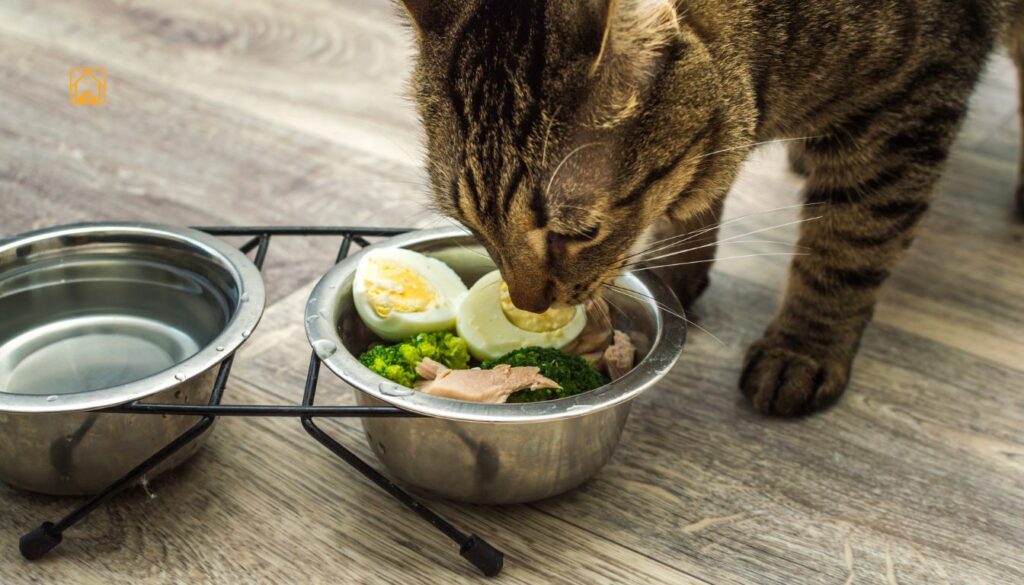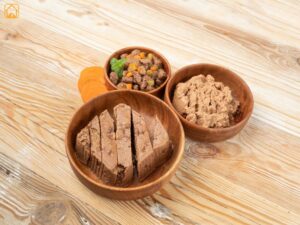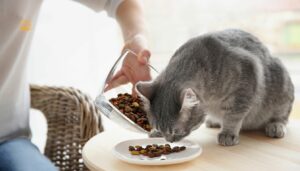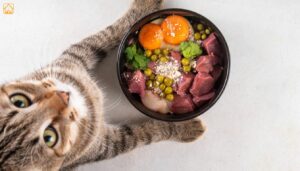What Is Homemade Cat Food?
Homemade cat food is any meal you prepare for your cat from scratch, using whole ingredients from your kitchen. Unlike commercial cat food, which is mass-produced and processed, homemade meals are crafted with your cat’s individual needs in mind. Recipes might be cooked or raw, and can be tailored for cats with allergies or special health needs.
Some pet parents cook chicken, turkey, or fish with veggies like pumpkin, while others try raw diets. But here’s the thing, homemade cat food is only healthy if it’s complete and balanced. That means getting all the essential nutrients right, not just using what’s left in the fridge. It’s a bit like baking a cake: miss one ingredient, and the result isn’t what you hoped!
Homemade vs. Commercial Cat Food: Key Differences
Let’s break down homemade cat food versus commercial cat food. Commercial foods are regulated, tested, and formulated to meet established nutritional standards (like AAFCO guidelines). They’re convenient, shelf-stable, and usually provide a complete diet, no guesswork required.
- Homemade cat food: Full control over ingredients, ideal for cats with allergies, and no preservatives. But, it requires careful planning to ensure nutritional adequacy.
- Commercial cat food: Convenient, widely available, and formulated for balance. However, some cats react to fillers or additives, and ingredient quality can vary.
Here’s the weird part, while many people assume home-cooked meals are healthier, cats have unique nutritional needs very different from humans. Skipping a supplement or ingredient could have big consequences for your cat’s health, especially over time.
Is Homemade Cat Food Healthier? Benefits & Potential Drawbacks
The big question, Is homemade cat food healthier? The answer depends on how well you meet your cat’s nutritional needs. Here are some homemade cat food benefits pet parents love:
- Control over every ingredient (great for allergies or sensitive stomachs)
- Freshness, no preservatives or unpronounceable additives
- Can be customized for special health conditions (with vet input)
But, let’s keep it real. Homemade cat food also has potential drawbacks:
- Hard to achieve homemade cat food nutritional balance without expert guidance
- Risk of missing essential nutrients (taurine, calcium, vitamin A, etc.)
- Food safety concerns, especially with raw diets
- It can get expensive and time-consuming
I’ve seen cats thrive on homemade diets when recipes are vet-approved and carefully planned. But I’ve also seen cats develop deficiencies when owners skipped steps or tried to “wing it.” So, is homemade cat food healthier? It can be, if you do it right.
Cooked vs. Raw Homemade Cat Food: Nutrition, Safety & Vet Perspectives
Feeding your cat homemade food can sound tempting especially if kibble or canned food feels boring. But whether it’s cooked or raw, preparing cat food at home carries real responsibilities and potential risks.
Cooked Homemade Cat Food
Cooking helps kill harmful bacteria like Salmonella, making meals safer for both cats and humans. It also breaks down enzymes in fish that block nutrients like thiamine. If a recipe is created by a board-certified veterinary nutritionist, cooked homemade diets can be as balanced and effective as commercial food. But most recipes you find online lack critical nutrients amino acids like taurine, vitamin E, calcium, and more so deficiencies are common without proper planning.
Raw Homemade Cat Food
Raw food mimics what wild cats eat using uncooked meats, organs, and sometimes bones. Some cat owners love it for glossy coats or smaller stools. But the downsides are real. Most raw meats are contaminated with bacteria like E. coli, Listeria, Salmonella, and studies show up to 86% of commercial raw diets tested contained unsafe levels. Beyond food safety risks, most raw recipes are also nutritionally unbalanced unless designed by a nutritionist
What Experts Recommend
Veterinary nutritionists stress that homemade diets should only be made with expert guidance. A homemade diet can be safe and balanced but only if it comes from a board-certified nutritionist who tailors it to your cat’s age, weight, and health. Without this, homemade meals risk nutrient gaps, bacterial contamination, and serious long-term health issues.
Handling and Hygiene
If you’re feeding raw food, follow strict hygiene, use separate prep surfaces, wash hands, sanitize bowls, and refrigerate food promptly. And know that even healthy cats can carry bacteria that could make humans sick.
Vet Perspectives and Comparison
| Type | Pros | Cons |
| Cooked | Safer, easier to supplement, reduces pathogens | May lose some nutrients if overcooked |
| Raw | Closer to wild diet, palatable to some cats | Risk of bacteria, harder to balance nutrients |
Most board-certified veterinary nutritionists recommend cooked homemade diets if you’re preparing food at home. If you’re determined to go raw, always consult your vet and use strict food safety protocols.
Nutritional Balance: Essential Nutrients, Supplements & Recipe Guidelines
Essential Nutrients for Cats
Cats are obligate carnivores, which means they have very specific requirements for protein, fat, vitamins, and minerals. Here’s what every homemade cat food recipe must provide:
- High-quality protein like chicken, turkey, fish, beef
- Taurine an amino acid crucial for heart and eye health
- Fatty acids like omega-3 and omega-6
- Calcium and phosphorus for healthy bones and teeth
- Vitamins A, D, E, and B-complex
- Trace minerals like zinc, iron, copper, etc.
Supplements for Homemade Cat Food
Even the best homemade cat food needs vet-approved supplements. Common homemade cat food supplements include taurine powder, fish oil, calcium (often from bone meal or eggshell powder), and a multivitamin designed for felines.
Recipe Guidelines & Vet Advice
Never rely on random internet recipes. Look for vet-approved homemade cat food plans or work with a board-certified veterinary nutritionist. Each cat is different, age, weight, health, and activity all affect what they need. Always:
- Use precise measurements, not estimates
- Follow recipes designed for cats, not dogs (their needs are different!)
- Balance protein, fat, carbs, and micronutrients
- Rotate recipes only if all are nutritionally complete
Safety Concerns & Risks: Toxins, Pathogens & Food Handling Tips
Homemade cat food isn’t just about nutrition, you’ve got to be vigilant about safety too. Common risks include:
- Toxins: Foods like onions, garlic, chocolate, grapes, and raisins are toxic to cats. Never include these.
- Pathogens: Uncooked meats can harbor bacteria and parasites. These pose risks for both cats and humans.
- Improper storage: Spoiled food can make cats sick. Always refrigerate or freeze meals promptly.
Safe Food Handling Tips
- Wash hands, surfaces, and utensils before and after preparing cat food.
- Use separate cutting boards for raw meats.
- Cook meats to recommended temperatures if not feeding raw.
- Store homemade food in airtight containers; discard leftovers after 2-3 days.
The Centers for Disease Control and Prevention (CDC) and FDA both warn about raw diets for pets due to infection risks. Even if you’re super careful, it’s not risk-free. If you’ve got kids or an immune-compromised family, cooked diets are safest.
How to Safely Transition Your Cat to Homemade Food & Monitor Health
Cats are notorious for being picky, and sudden diet changes can upset their stomach or cause them to refuse food. Here’s how to make a gradual switch to homemade cat food:
- Start by mixing a small amount of homemade food with your cat’s current food.
- Increase the homemade portion slowly over 7-10 days.
- Watch for digestive upset (vomiting, diarrhea, constipation).
- Track weight, energy, and coat condition.
- Schedule regular vet check-ups for ongoing monitoring.
One pet parent told me her cat “boycotted” new food for days, only to come around after a slower transition. And remember, if your cat stops eating or seems unwell, check with your vet right away.
Practical Considerations: Time Commitment, Cost, and Vet Collaboration
Making homemade cat food isn’t as simple as tossing chicken in a bowl. Here’s what to expect:
- Time commitment: Shopping, prepping, cooking, and cleaning up can take several hours a week.
- Cost: Quality ingredients and supplements may cost more than commercial food, depending on recipes.
- Vet collaboration: Regular check-ins with your vet ideally a board-certified nutritionist are a must to monitor homemade cat food nutrition risks and adjust recipes as your cat’s needs change.
I won’t lie, there were weeks I questioned the effort. But seeing my cat’s shiny coat and happy zoomies made it all worth it. If you’re ready to commit, plan ahead and don’t go it alone. Your vet is your best partner for success.
FAQs About Homemade Cat Food
Is homemade cat food really better than commercial diets?
Homemade cat food can be great if it’s nutritionally complete and vet-approved. Many commercial diets are balanced and convenient, but some cats do better on homemade, especially with allergies or special needs. It’s the quality of the recipe and oversight that matters most.
How do I know my homemade cat food has all the nutrients my cat needs?
Work with your vet or a veterinary nutritionist to create or review recipes. Use precise measurements and appropriate supplements. Monitor your cat’s health with regular vet visits and blood tests.
Are raw homemade cat foods safe for cats?
Raw diets carry a higher risk of bacteria and parasites, which can harm both cats and humans. If you choose raw, use only human-grade meats, follow strict hygiene, and consult your vet first. Many experts prefer cooked diets for safety.
Can I use dog food recipes for my cat?
No, cats and dogs have different nutritional needs. Cats require taurine, vitamin A, and arachidonic acid, nutrients that may be missing in dog food recipes. Stick to feline-specific, vet-approved recipes only.
What are signs my cat isn’t tolerating homemade food?
Watch for weight loss, digestive upset, poor coat, lethargy, or changes in appetite. If you spot any of these, revert to your previous diet and call your vet right away.
How often should I check in with my vet about my cat’s homemade diet?
Schedule a checkup at least every 6-12 months, or sooner if your cat has health concerns. Your vet can monitor for deficiencies and suggest recipe changes as needed.
What’s the biggest mistake pet parents make with homemade cat food?
The most common mistake is skipping essential supplements or not balancing nutrients. Even the best ingredients can’t make up for missing vitamins or minerals. Always double-check recipes with an expert.
Conclusion
Homemade cat food can be a healthy, loving choice when done right. With careful planning, safe ingredients, and regular vet guidance, you can give your cat balanced meals made with care. Remember, every cat is different, so listen to their needs and enjoy the journey of feeding from the heart.



